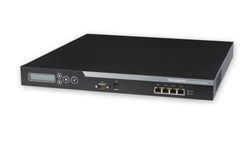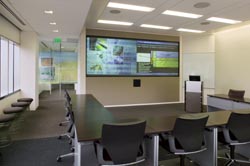- IBM's Software Executive Briefing Center in San Jose, CA, utilizes a triple array of Sony VPL-FX51 network projectors, a Polycom VSX-8800 videoconferencing codec, ClearOne XAP800 audio mixer, Atlas ceiling speakers, and a Shure wireless microphone system. An AMX control system with 15-inch touchscreen panels was installed in each room to control and monitor the AV systems.If there is one area of the AV business that might actually benefit from the prospect of an economic downturn, it's videoconferencing. After all, the proponents of this technology have long boasted of its ability to reduce customer costs by cutting down on employee travel, saving time, and generally increasing efficiency.
- Yet to view videoconferencing technology within such a narrow framework is to do the sector something of an injustice. Sure, it has the potential to reduce the amount of time and money companies spend on arranging national and international meetings. But today's videoconferencing products-higher quality, more reliable, and, perhaps most important, better integrated into other areas of AV and IT system design-can do so much more.
- In fact, according to some industry personalities, attempting to sell a videoconferencing solution purely on the basis that it is a cost-effective replacement for air miles might easily backfire. "A lot of corporate customers actually foster employee travel, because it enables people to build one-to-one relationships, and gain awareness of their peers' communities and values," said Rod Andrewson, manager of systems engineering for CCS Presentation Systems in Scottsdale, AZ.
- What really pushes corporate buttons, Andrewson adds, is videoconferencing's ability to transform employees' quality of life, specifically, the way it allows them to communicate globally from the comfort of their home office, a world away from the mayhem of traffic delays and airport security checks.
- Videoconferencing has come a long way since the days of high-priced corporate studios, but as Robert Lopez, product services manager at network technology distributor Westcon Group, recalls, it hasn't all been smooth sailing. "The trend has been driving the technology out to the masses, but although the hardware became much more affordable, the next roadblock we ran into was that the networks weren't ready. We had ISDN, but the quality wasn't there because the network bandwidth wasn't there."
- Even today, bandwidth can still be an issue. Videoconferencing hardware vendors may be doing all they can to persuade customers to adopt the latest in HD solutions, but not everyone can justify investing in a network that is 100-percent HD-ready. No matter, said Westcon's Lopez. "When you start talking about HD, it's clear that many enterprises still don't have the network infrastructure to support it," he said. "But even with lower data rates, you benefit from it. Two years ago, a typical videoconference resolution was somewhere between VHS tape and regular TV. With HD, you're getting closer to DVD quality, even on low-end networks. At lower data rates you won't get true HD, but if you have HD endpoints [cameras , codecs, and monitors], you're still looking at four times SD resolution."
SPL's design forms an innovative, consolidated layout with the three IBM conference rooms sharing one rear-projection space.
Andrewson agrees, arguing that specifying HD endpoints is the best way of ensuring that customers can future-proof their videoconferencing investment. "If you want equipment that can last between three and five years, then HD is good value," he said, "even if you're not going to be able to provide very high bandwidth to start with."
The increase in image detail, enhanced audio quality, and greater robustness of communication promised by HD have always been attractive on paper. What has surprised many in the industry is the sheer diversity of customer these assets appeal to, and the range of factors that can influence their thinking.
As Mike Sekiguchi, director of Sony's IPELA Communications Group, said, "We introduced our first HD product two years ago, and at first, in terms of display, cost, size, and network bandwidth, the market wasn't quite ready for it. Since then we've been surprised at how many applications have come onboard, and how quickly."
In our increasingly globalized economy, such applications can only grow in number as time goes on. But it is important to remember that this form of communication is not the sole province of huge, established, multinational companies. As Craig Malloy, CEO of LifeSize, put it, "The biggest growth opportunity is the SME. They have the networks, they have global potential-and yet there is almost no penetration [of HD videoconferencing] within that sector."
"Right here in Austin," Malloy continued, "there's a company that has an office here and an office in Bangalore, India. They use our systems to communicate daily, and we've changed the way they do business."
A recurring theme among videoconferencing professionals is that the technology doesn't simply enable meetings to take place without moving participants halfway around the planet. It enables more meetings, period. For some time now, the industry's holy grail has been the full-blown 'telepresence' environment, in which two sets of individuals spend whole days in each other's company without actually meeting.
"The concept," Andrewson said, "is that you create half a meeting room, and you have complete symmetry with the other 'half' of the room in the remote location. Everything that goes on is developed together-even to the extent that both teams have the same lunch!
"I've been lucky enough to have been in several well-designed telepresence suites, and it's an amazing experience. The people are the same size as you are, the same distance away that they would be if they were just across the table. The audio quality is extremely good-it doesn't sound amplified. You literally forget that you're not in the same room.
"But although the costs have come down exponentially, it's still a very expensive thing to do. It has very specific hardware requirements to do it correctly, it requires very specific architectural design, and it requires much more space than traditional videoconferencing."

Tandberg's Content Server
Tandberg Delivers Content
Once the sole province of third-party vendors and their proprietary solutions, content management is now being offered by most of the major videoconferencing manufacturers. Reaffirming this trend, Tandberg has unveiled a new version of its Content Server, designed to increase the versatility of recorded high-definition video and multimedia presentations. Users can create, store, download and distribute video calls and multimedia presentations, providing viewers with the flexibility to access content anytime and through multiple devices.










